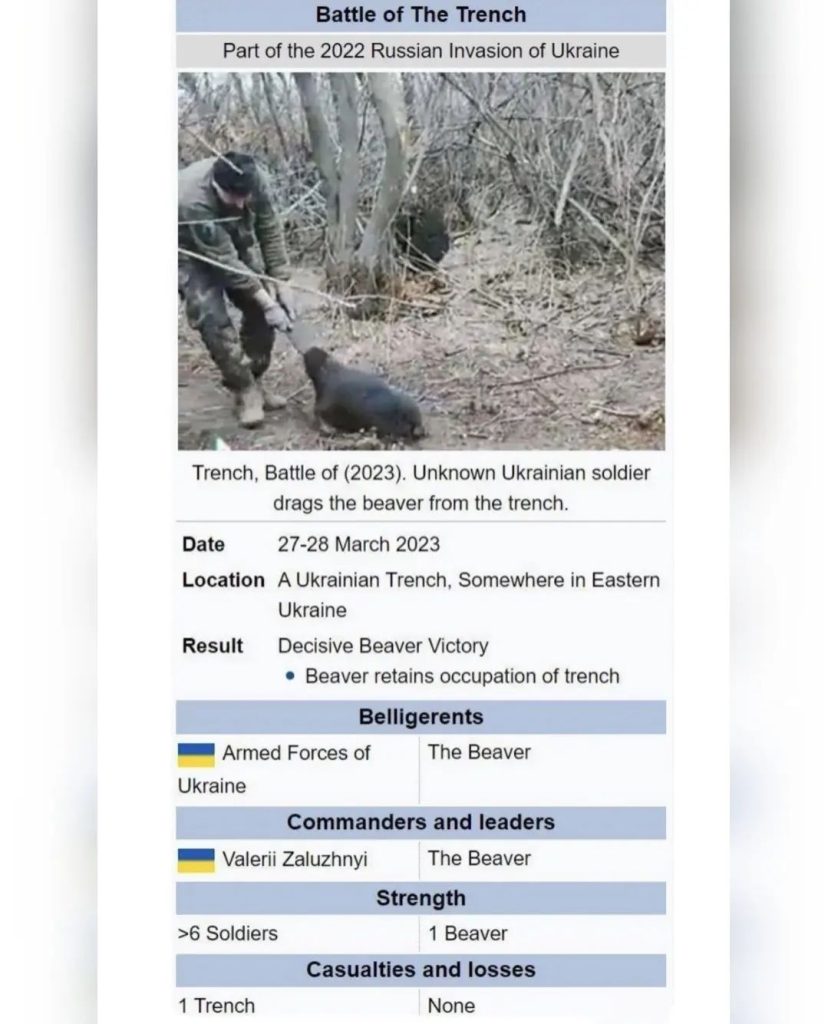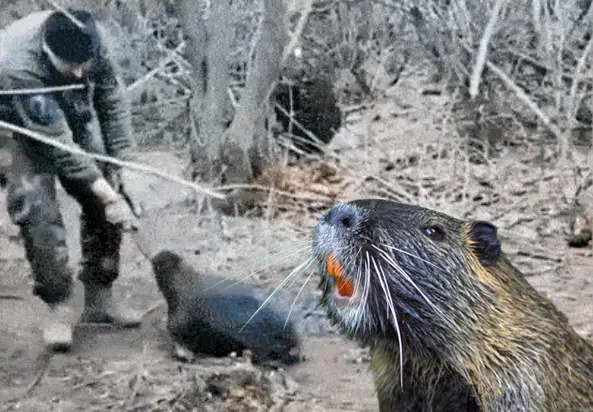Warning. This is uncensored battlefield footage. Trigger warning for sissies and people who don't like beavers.

As you'll see, our protagonist is dragged free of the trench by a Ukrainian soldier. We cannot independently confirm whether the beaver is responsible for the entrenchment he's attempting to control, but it seems likely. Castor fiber (that's the species of beaver native to the region) is known to be an industrious and skilled worker, and as such often prefers to serve in a combat engineer role.


Many people are unaware that Castor fiber, or “Eurasian beaver” was hunted almost to extinction in the early 20th century but over the last couple of decades has been slowly regaining its former territory.
Not surprising, given the level of tenacity we see displayed here.
Unconfirmed reports say War Beaver is a former associate of Honey Badger.
Note: this is not the same Battle of the Trench that took place during the Muslim–Quraysh War in 627AD.
Defensive Fighting Position (DFP)
For those who aren't familiar with the term: a defensive fighting position is a fortified position, often rudimentary, capable of protecting one or more combatants from incoming fire. The DFP, which may or may not be a fighting hole (“military foxhole”) is something that is to be continuously improved as time and conditions allow (per the military's Priorities of Work).
Properly constructed, a fighting position will include overhead cover for protection from indirect fire, a grenade sump, and ideally a water sump. It will also be a part of a fire plan sketch and local range cards.
One acronym used as a mnemonic for the Priorities of work is SAFE-SOC:
Security (establish it)
Automatic Weapons (position them)
Fields of Fire (clear them)
Entrench (work on the DFP itself)
Supplementary and Alternate Fighting Positions
Obstacles (emplace or build them)
Camouflage
These actions are an ongoing cycle, integrated with other tasks like personal hygiene, weapon maintenance, etc.
Wikipedia explains it thusly:
Initially, a shallow “shell scrape” is dug, often called a ranger grave, which provides very limited protection. Each stage develops the fighting position, gradually increasing its effectiveness, while always maintaining functionality. In this way, a soldier can improve the position over time, while being able to stop at any time and use the position in a fight.
Typically, a DFP is a pit or trench dug deep enough to stand in, with only the head exposed, and a small step at the bottom, called a fire step, that allows the soldier to crouch on to avoid fire and tank treads. The fire step usually slopes down into a deeper narrow slit called a grenade sump at the bottom to allow for live grenades to be kicked in to minimize damage from grenade fragments.
When possible, DFPs are revetted with corrugated iron, pickets, and wire or local substitutes. Ideally, the revetting will also be dug in below ground level so as to minimize damage from fire and tank tracks. The revetting helps the DFP resist cave-in from near misses from artillery or mortars and tank tracks.
Time permitting, DFPs can be enlarged to allow a machine gun crew and ammunition to be protected, as well as additional overhead cover via timbers.
Developing and maintaining DFPs is a constant and ongoing task for soldiers deployed in combat areas. For this reason, in some armies, infantry soldiers are referred to as “gravel technicians”, as they spend so much time digging.
Read this article in its entirety at Breach Bang Clear.
READ NEXT: House Oversight Committee Subpoenas Major Banks For Biden Family Financial Records



Wisconsin could use that fellow. Go Bucks!
Odd did this occur during WW1 on Western Front?